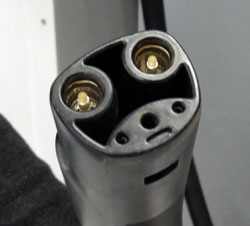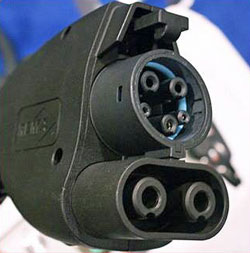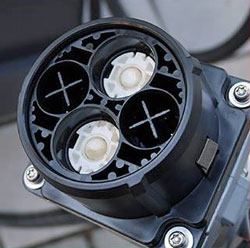DC Fast Charging

When your trip length is longer than your EV's range, you need to recharge while driving. In practice, this means recharging at a "DC Fast Charging Station". Since a regular public charging station will only give you about 20 miles of range per hour of charging, this usually won't be useful. A 250 kW DC Fast Charger can give you up to 250 miles of range in only 15 minutes, so a well timed lunch or restroom break will set up you up for the next leg of your trip.
The reason these fast charging stations are sometimes called "DC" stations is that they pump Direct Current (DC) electricity into your car instead of the Alternating Current (AC) that comes from the electric grid. Your car battery supplies and gets recharged using DC current. When you give it AC current via your EVSE or public charger, the car has an on board charger that converts the supplied AC to DC for the battery. That's why different EVs have different maximum kW or amp ratings for recharging via AC power: their on board charger has different capabilities.
So a DC charging station has a much larger AC to DC converter built into the charging station and feeds DC current directly into your battery bypassing your car's on board charger. This allow you to charge much faster.
There are three types of DC Fast Chargers in the US and Canada, one of which is pretty much obsolete, another is on its way out. In a couple of years, we'll have coalesced into a single charging standard (Tesla/NACS).
Tesla Superchargers are the most ubiquitous, most reliable fast charger network. All Teslas can charge at them, and many have been retrofitted with "Magic Docks" that allow all non Tesla vehicles to charge at them. In addition, many non Tesla EVs are able to charge at other Tesla Superchargers via an adapter. Here's a picture of the Tesla/NACS plug.

CCS is supported by European and domestic EVs (Tesla can use these fast charge stations via an adapter). It is expected that over time all CCS fast charging stations will convert over to the Tesla/NACS plug. CCS Charge plug:

CHAdeMO is supported by older Japanese EVs and Teslas (via an adapter, now only found on eBay). It is a de facto dead standard. The plug looks like this:

Regardless of which Fast Charging standard your car can support, you must make sure your car is equipped with Fast Charging as it sometimes an extra cost option, although newer EVs always have fast charge capability.
Charging Network Membership

DC Fast Charging stations typically require membership in some sort of payment plan. Use PlugShare to find out which payment plans you need for the Fast Chargers along your route.
Just use the Tesla app to set up an account and charge at Tesla Superchargers.
Here are some links to common charging networks: ChargePoint, EvGo, Blink, Shell Recharge, Electrify America.
Finding Fast Chargers
Use PlugShare with a 50 kW or greater filter to find DC Fast Chargers.
The best way to find and plan out usage of fast chargers is to use A Better Route Planner which uses your EV's characteristics and other info you can enter to plan out a long trip with suggested charging stops along your route. I never do a long distance drive without entering my plan into ABRP first.
Fast Charging Tips
A battery that is 80% full cannot accept the full power of a DC fast charger. Similarly, to get the maximum charge rate from a 250 kW DC fast charger, your battery must typically have less than 20% battery remaining. So on a long trip it makes sense to drive until your battery is fairly empty before recharging.
Unless you are right at your range limit to get to your next stop, it never makes sense to fully recharge your battery at a DC fast charger. To minimize trip time, charge just enough to get to your next stop plus a 10%-20% range buffer (how much buffer you need depends on your experience estimating actual range needed for your driving style, and other variables such as elevation, wind, temperature extremes, etc.).
If you put in a Tesla Supercharger into your Tesla navigation map (or if you are relying on Tesla's trip navigation), the car will pre-condition the battery as it gets close to the Supercharger to allow it to accept the maximum charge rate. This is especially important in the winter as a cold battery cannot be charged as quickly.
Great Video
Here's a great YouTube video explaining everything you need to know about DC fast charging (aimed for non-Tesla EVs).
